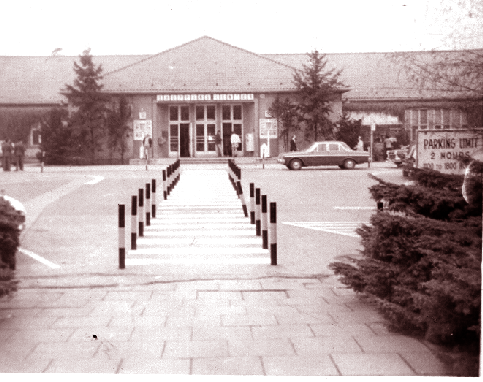

Dahlem Retains Many historic References to Its Past
Last week in this column it was mentioned
that centuries old Dahlem, a medieval village that today forms an important
section of the borough of Zehlendorf, retains many historic references to its
antiquity. Perhaps nothing more truly illustrates this than the existence of the
Sankt Annen-Kirche at Pacelliallee and Koenigin-Luise-Strasse. This church, one
of Berlin's most durable Houses of God, has survived 760 years, a dozen wars and
the neglect of disinterested parishoners. Originally the church was Catholic,
consecrated to Saint Ann. In the years of the Reformation the church became
Lutheran, keeping, however, its old name. Through the years the church has
undergone several periods of archi- tectural transformation. First constructed
in the Roman style, the church received additions of vaulted ceilings and
stained glass windows in 1420, showing the influence of Gothic architecture.
During the Reformation the church underwent renovation in the baroque style
under the patronage of the von Wilmersdorf family. Since World War II, the
church has become a favorite historical setting for weddings and services are
still conducted there on a regular schedule. Dahlem Museum However, Dahlem's
interest in and dedication to the preservation of historical relics encompasses
much more than its own centuries-old traditions. The famed Dahlem Museum was
constructed in 1916 as the museum center for Asiatic Art. Since that time the
museum building has been enlarged to accommodate a sculpture department, a
picture gallery and a cabinet of engravings. The Picture Gallery provides an
excellent general survey of European painting until 1800, from the beginnings of
panel-painting in the 13th century down to the great masters of rococo. The
Rembrandt collection numbering 26 pieces is the largest in the world. The
Cabinet of Engravings is the youngest of the great European graphic collections
but is hardly inferior to those of London, Paris and Vienna in quality and
quantity. The collection of Duerer's drawings and engravings is incomparable in
its diversity. The museum also boasts a fine collection of artifacts from the
Inca and Aztec civilizations of South America, as well as sections on the
Pacific Islands, Japan, China and Africa. Until the past year, when the Egyptian
Section was moved to the Charlottenburg Castle, the museum was the abode of the
famed bust of Nefertiti. American Facilities The American facilities in Dahlem
include the Berlin Brigade Headquarters Compound, both American schools, the
Berlin American Community Chapel, the Harnack House, Turner Barracks and the
main European Exchange Shopping Center in Berlin. What today is the Berlin
Headquarters Compound was during World War II Luftgau Headquarters the command
post for the aerial defense of the eastern region of Germany. On July 4, 1945
the American flag flew for the first time over the compound when the American
forerunner of the Berlin Brigade, set up headquarters in the Luftgau buildings.
The Thomas A. Roberts School, named in honor of the lieutenant colonel of that
name who was the first American to lose his life in the Battle of Berlin, was
constructed in 1953 to meet the educational needs of the increased number of
school age dependents. The Berlin American High School, officially opened in
1965, is a $2-million structure equipped with a library of over 7,000 volumes
and 26 general purpose classrooms. Total enrollment at both schools is
approximately 2,000. The Berlin American Community Chapel was dedicated in
December 1957. Until that time there was no chapel in the vicinity of the
American community housing area. Harnack House Once the guest house of the
Kaiser Wilhelm Society, the Harnack House is today an officer-civilian club and
provides facilities for balls, parties and dining. The house bears the name of
the first president of the Society for Furthering of the Sciences, Adolf von
Harnack. It was inaugurated on his 78th birthday, May 7, 1929. Turner Barracks
on Huettenweg today houses Company F, 40th Armor, stationed in Berlin since May
1958. The Barracks was formally dedicated in February 1952 and was named in
honor of Sergeant First Class Charles W. Turner, who was posthumously awarded
the Medal of Honor for gallantry in Korea in September 1950. Before the arrival
of Company F, the barracks housed the 6th Infantry Regiment Tank Company.
Shopping Center The European Exchange Store on Clayallee was opened in July 1946
as a Consolidated Mess Hall and was named Truman Hall after the American
President who was present at the official flag-raising ceremony at the
Headquarters Compound on July 20, 1945. The building was the first completely
new building constructed by U. S. Engineers in the American sector of Berlin. In
June 1950 the building became the shopping center for the American forces in
Berlin.

Next |
Back to the front page |